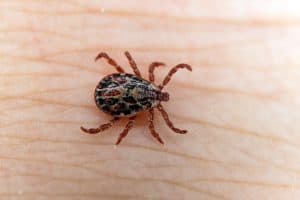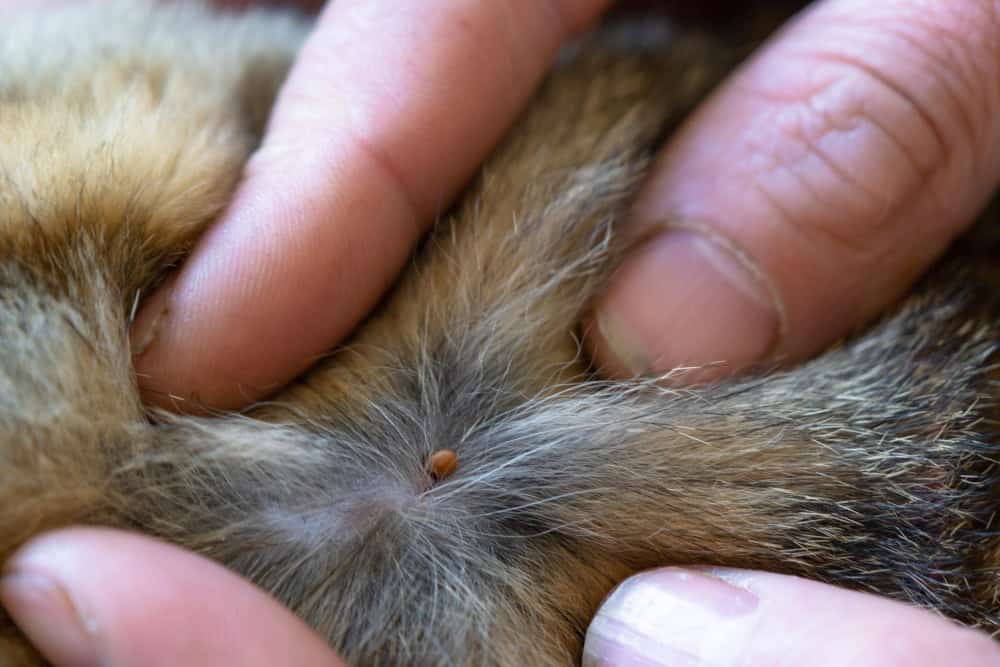The dog tick is a blood-sucking parasite that poses a problem for dogs worldwide. Besides dogs, they can also be dangerous to other animals and humans. Due to climate change, we can expect constant tick invasions, and these unpleasant parasites may appear earlier than usual this year.
Types of Dog Ticks

- Dermacentor reticulatus (ornate cow tick)
- Ixodes ricinus (common tick)
- Rhipicephalus sanguineus (brown dog tick)
Appearance
Ticks have flat, oval bodies that swell during blood-feeding. Their color can vary depending on the species and their feeding state but are generally brown or grayish.
Lifestyle and Reproduction
Ticks have a four-stage lifecycle: egg, larva, nymph, and adult. Females lay thousands of eggs, which hatch into larvae. The larvae feed on the blood of smaller animals and then turn into nymphs. Nymphs feed on the blood of larger animals, such as dogs, and develop into adult ticks. Adult ticks also feed on blood to reproduce.
Finding Hosts and Blood Feeding
Dog ticks do not jump but crawl onto their hosts from vegetation. They use their Haller’s organs to sense air movement, humidity, and carbon dioxide levels, helping them locate new targets. Their salivary glands enable them to feed unnoticed, as their saliva reduces the host’s response, making it easier to transmit pathogens into the host’s body.
Ticks can be found outdoors anywhere, with few natural enemies. They are mainly active from spring to autumn, but mild weather can make them present even in winter. They prefer humid places, often found in leaf litter and dense vegetation. Ticks do not attack from tree tops but crawl up from the ground. They wait in tall grass and bushes until a host animal passes by, then latch on and feed on blood.
Diseases Transmitted by Ticks
Ticks can transmit several diseases dangerous to dogs:
- Lyme disease: Caused by bacteria, leading to joint inflammation, fever, and lethargy.
- Babesiosis: Caused by a parasite attacking red blood cells, potentially fatal in severe cases.
- Anaplasmosis: Also caused by bacteria, leading to fever, weakness, and anemia.
Ticks in Dogs

- Tick removal: Carefully remove the tick using a special tick tweezer.
- Veterinary check-up: If the dog appears lethargic, take it to the vet for appropriate treatment, such as antibiotics or antiparasitic medications.
Prevention and Protection
- Tick repellents: Use vet-recommended tick-repellent collars, drops, or tablets.
- Garden maintenance: To protect against ticks, keep the garden well-maintained. Ticks dislike sunny, dry places, so separate grassy and wooded areas, and cover the ground with mulch or gravel. Garlic oil and cedar oil can effectively reduce the number of nymph-stage ticks and block insect scent receptors.
- Regular checks: After walks, thoroughly check the dog’s fur and skin, especially around the ears, under the neck, between the legs, and at the base of the tail. If you find a tick, remove it immediately with a special tick removal tool to minimize the risk of infection. Be careful to remove the tick’s head, as leaving it in the skin can cause inflammation.
Natural Enemies of Dog Ticks
- Fungi: The fungus Metarhizium anisopliae can infect and kill ticks.
- Nematodes: The nematode Steinernema carpocapsae can also be effective against ticks.
Natural Protection
Natural repellents include apple cider vinegar and lemon spray. Dilute apple cider vinegar with water in a 1:1 ratio and spray it on the dog. To make a lemon spray, cut a lemon, pour hot water over it, let it sit overnight, then fill a spray bottle and apply it to the dog’s coat.
Apple cider vinegar, among its many benefits, makes the dog’s blood more acidic, making it less attractive to ticks.
You can sprinkle diatomaceous earth on your dog’s bed, which dehydrates and kills ticks. While harmless to humans and animals, inhaling it can cause irritation, so use it cautiously.
Protecting Dogs
Regular checks and preventive measures are crucial to protect dogs. If you find a tick on your dog, remove it immediately and monitor the dog for signs of illness. Following the vet’s advice and using appropriate treatment methods is essential for your dog’s health.
Besides vet-recommended products, natural methods can also be used but should be supplementary or used during less active periods.
Read similar articles about dog fleas, various dog sports, or living with dogs.


